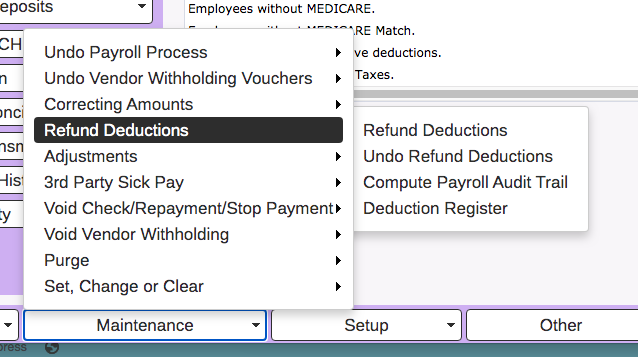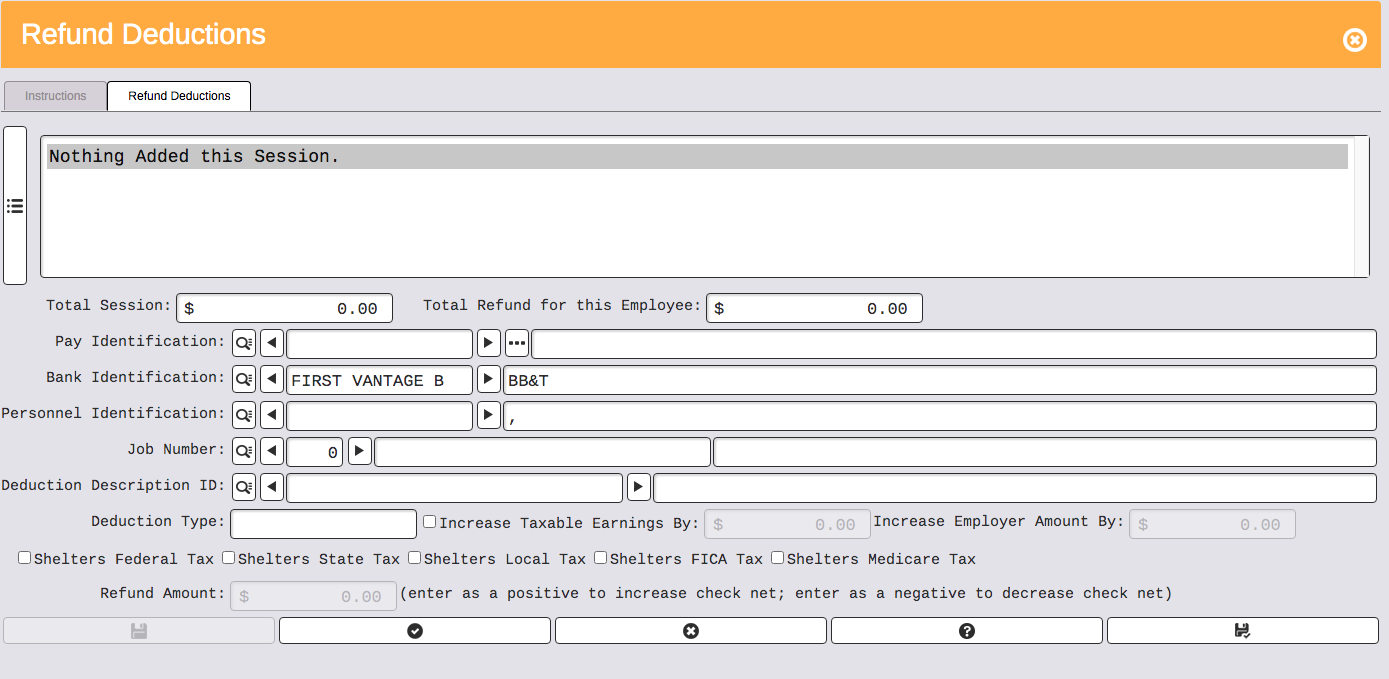What This Process Does
- Issues refund checks for pre or post tax employee paid deductions for employees that are no longer active or being paid (Direct Deposit is not available on this refund process).
- Employees can be current or non-current, jobs can be active or inactive and deductions can be active or inactive
- Allows for updating taxable wages for both employee and employer paid taxes.
- Adds liability or credit to Deduction Accounts for payment in Vendor Withholding.
- The Refund Deduction process cannot be used to correct non tax employer paid deductions; Board Paid Benefits Only payroll should be used.
Best Practices
- Not Active or Guaranteed - Refund Deductions process should be used for employees that are no longer active or are not guaranteed future pay. If employees will be paid again, refunds can be included in the next payroll, or the Refund Deduction payroll can be used if the refund needs to be issues before the next payroll
Refund Deductions
- HR → Payroll → Pay Master /Pay ID to create a unique Pay ID for the Refund (Pay date can be current date unless refund is for previous tax year-check date, calendar and fiscal periods must be for previous year), Pay Type should be REGULAR and calendar and fiscal periods should follow the pay date
- Payroll → HR → Payroll → Maintenance → Refund Deductions
- Refunds are by check only.


| FIELDS | Opt. | Rec. | Req. | Description |
|---|---|---|---|---|
| Pay Identification | — | — | ♦ | Browse for the Pay ID created for the refund |
| Bank Identification | — | — | ♦ | Browse for the bank used for the refund |
| Personnel ID | — | — | ♦ | Browse for the employee due the refund (employee does not need to be current) |
| Job Number | — | — | ♦ | Browse for the job number that the deduction being refunded was originally expensed (job does not need to be active) |
| Deduction Description ID | — | — | ♦ | Browse for the deduction that is being refunded back to the employee (employee deduction does not need to be active but Deduction Description must be active) and browse for tax deductions that need increase/decrease in taxable wages and amounts withheld/refunded if refunding pre-tax deduction (See examples below) |
| Opt. = Optional Rec. = Recommended Req. = Required | ||||
- An entry must be done for all affected deduction accounts on the Refund Deductions screen whether your refund is an After Tax Deduction or Tax Sheltered Deduction. Use the examples below to determine what deduction types need adjustment and whether the deduction adjustment is employer or employee, positive or negative.
- Once you complete the entry for the refunded deduction and tax deductions (if pretax refund), return to the Maintenance - Refund Deductions - Compute Payroll Audit Trail. Select the pay id for the refund and set the flags. (If the RDA version does not have the Compute Audit trail, move to the next step - Deduction Register).
- Once the flags are set on the Compute Payroll Audit Trail, return to the Maintenance - Refund Deductions - Deduction Register. Select the pay id for the refund and set the flags.
- Once the Deduction Register flag is set, return the main payroll menus beginning with Make Transactions and continue as if it were a normal payroll process all the way thru Post Activity.
Guidelines for Refunding Pre and Post-Tax Deductions
- The following is a guideline for completing the fields at the bottom of the refund deductions screen based on whether the deduction was pre-tax or post-tax.
- All amounts for refunded deductions and taxable earnings and tax amounts must be manually entered (If refunding a partial direct deposit amount, please see section, Refund Partial Direct Deposit):
- Check the box, Increase Taxable Earnings in order to key in the increase (or decrease) of taxable earnings. A positive amount indicates increase and a negative amount indicates decrease.
Example 1: Refund an After-tax deduction
| Increase Taxable Earnings | Increase Employer Amount | Refund Amount | |
|---|---|---|---|
| After-tax Deduction (example for $200.00) | NOT REQUIRED | NOT REQUIRED | $200.00 |
| Net Refund Amount (amount of check) | $200.00 |
Example 2: Refund a Pre-tax deduction which: Sheltered Federal, State, FICA and Medicare
| Increase Taxable Earnings | Increase Employer Amount | Refund Amount | |
|---|---|---|---|
| Pre-tax deduction (example for $250.00 deduction) | $0.00 | $0.00 | $250.00 |
| Federal Deduction• | $250.00 | $0.00 | $0.00 |
| State Deduction• | $250.00 | $0.00 | $0.00 |
| FICA Deduction | $250.00 | $0.00 | -$15.50 |
| FICA Match Deduction | $250.00 | $15.50 | $0.00 |
| Medicare Deduction | $250.00 | $0.00 | -$3.63 |
| Medicare Match Deduction | $250.00 | $3.63 | $0.00 |
| Net Refund Amount (amount of check) | $230.87 |
Example 3: Refund a Pre-tax deduction which: Sheltered Federal and State
| Increase Taxable Earnings | Increase Employer Amount | Refund Amount | |
|---|---|---|---|
| Pre-tax deduction (example for $300.00 deduction) | $0.00 | $0.00 | $300.00 |
| Federal Deduction• | $300.00 | $0.00 | $0.00 |
| State Deduction• | $300.00 | $0.00 | $0.00 |
| Net Refund Amount (amount of check) | $300.00 |
•NOTE: Examples for Federal and State deductions do not show any amount in the refund amount column. If desired, you can calculate the applicable amount of Federal and State tax and enter as a negative amount.
- In addition, if taxable earnings should be decreased, enter a negative amount in the Increase Taxable Earnings field.
- Once Refund Amounts are entered, run the Compute Audit Trail, Deduction Register, then return to the Payroll Processing menu on the left and continue the steps to process the payroll beginning with Make Transactions.
- If a refund was received by the vendor, the amount of the refund should be added to the Deduction Account, as well as a balance sheet receipt should be entered in Financial Management debiting cash and crediting the Deduction Payable account.
Undo Refund Deductions
- If any deductions are entered incorrectly for an employee (amount or taxable wages), the employee must be removed from the Refund Pay Master and entered again. If you have already set the Make Transactions flag or any flags after Make Transactions, be sure to undo using the Payroll Undo Menu first.
- Payroll → HR → Payroll → Maintenance → Refund Deductions → Undo Refund Deductions
- Select Pay Identification for Refund.
- Range on Personnel ID or don't range if all employees should be removed.
- Click on Select.
